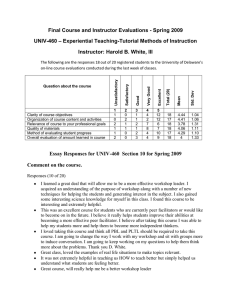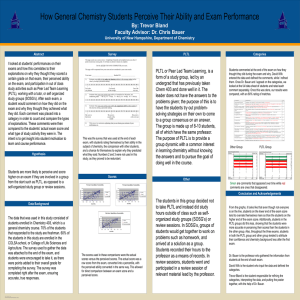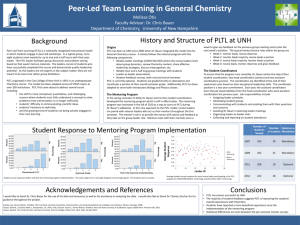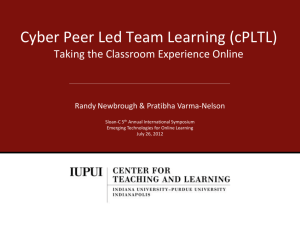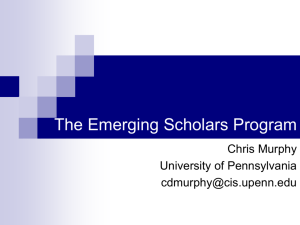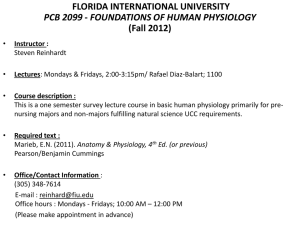Students in introductory chemistry sequences often are not
advertisement
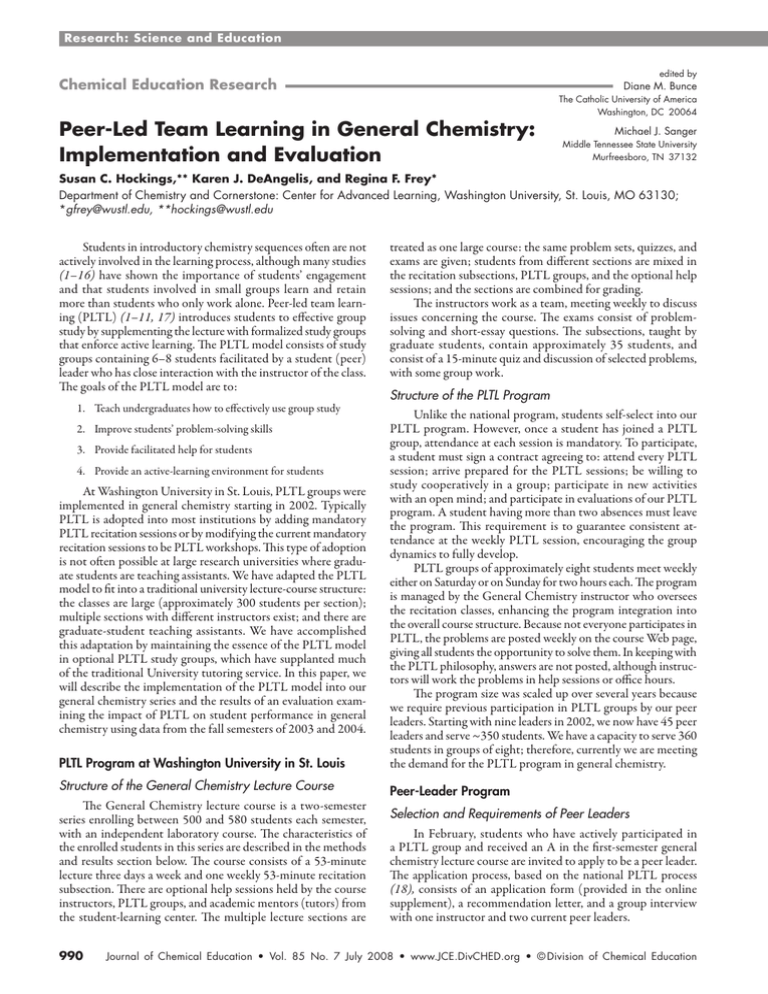
Research: Science and Education edited by Chemical Education Research Diane M. Bunce Peer-Led Team Learning in General Chemistry: Implementation and Evaluation The Catholic University of America Washington, DC 20064 Michael J. Sanger Middle Tennessee State University Murfreesboro, TN 37132 Susan C. Hockings,** Karen J. DeAngelis, and Regina F. Frey* Department of Chemistry and Cornerstone: Center for Advanced Learning, Washington University, St. Louis, MO 63130; *gfrey@wustl.edu, **hockings@wustl.edu Students in introductory chemistry sequences often are not actively involved in the learning process, although many studies (1–16) have shown the importance of students’ engagement and that students involved in small groups learn and retain more than students who only work alone. Peer-led team learning (PLTL) (1–11, 17) introduces students to effective group study by supplementing the lecture with formalized study groups that enforce active learning. The PLTL model consists of study groups containing 6–8 students facilitated by a student (peer) leader who has close interaction with the instructor of the class. The goals of the PLTL model are to: 1. Teach undergraduates how to effectively use group study 2. Improve students’ problem-solving skills 3. Provide facilitated help for students 4. Provide an active-learning environment for students At Washington University in St. Louis, PLTL groups were implemented in general chemistry starting in 2002. Typically PLTL is adopted into most institutions by adding mandatory PLTL recitation sessions or by modifying the current mandatory recitation sessions to be PLTL workshops. This type of adoption is not often possible at large research universities where graduate students are teaching assistants. We have adapted the PLTL model to fit into a traditional university lecture-course structure: the classes are large (approximately 300 students per section); multiple sections with different instructors exist; and there are graduate-student teaching assistants. We have accomplished this adaptation by maintaining the essence of the PLTL model in optional PLTL study groups, which have supplanted much of the traditional University tutoring service. In this paper, we will describe the implementation of the PLTL model into our general chemistry series and the results of an evaluation examining the impact of PLTL on student performance in general chemistry using data from the fall semesters of 2003 and 2004. PLTL Program at Washington University in St. Louis Structure of the General Chemistry Lecture Course The General Chemistry lecture course is a two-semester series enrolling between 500 and 580 students each semester, with an independent laboratory course. The characteristics of the enrolled students in this series are described in the methods and results section below. The course consists of a 53-minute lecture three days a week and one weekly 53-minute recitation subsection. There are optional help sessions held by the course instructors, PLTL groups, and academic mentors (tutors) from the student-learning center. The multiple lecture sections are 990 treated as one large course: the same problem sets, quizzes, and exams are given; students from different sections are mixed in the recitation subsections, PLTL groups, and the optional help sessions; and the sections are combined for grading. The instructors work as a team, meeting weekly to discuss issues concerning the course. The exams consist of problemsolving and short-essay questions. The subsections, taught by graduate students, contain approximately 35 students, and consist of a 15-minute quiz and discussion of selected problems, with some group work. Structure of the PLTL Program Unlike the national program, students self-select into our PLTL program. However, once a student has joined a PLTL group, attendance at each session is mandatory. To participate, a student must sign a contract agreeing to: attend every PLTL session; arrive prepared for the PLTL sessions; be willing to study cooperatively in a group; participate in new activities with an open mind; and participate in evaluations of our PLTL program. A student having more than two absences must leave the program. This requirement is to guarantee consistent attendance at the weekly PLTL session, encouraging the group dynamics to fully develop. PLTL groups of approximately eight students meet weekly either on Saturday or on Sunday for two hours each. The program is managed by the General Chemistry instructor who oversees the recitation classes, enhancing the program integration into the overall course structure. Because not everyone participates in PLTL, the problems are posted weekly on the course Web page, giving all students the opportunity to solve them. In keeping with the PLTL philosophy, answers are not posted, although instructors will work the problems in help sessions or office hours. The program size was scaled up over several years because we require previous participation in PLTL groups by our peer leaders. Starting with nine leaders in 2002, we now have 45 peer leaders and serve ~350 students. We have a capacity to serve 360 students in groups of eight; therefore, currently we are meeting the demand for the PLTL program in general chemistry. Peer-Leader Program Selection and Requirements of Peer Leaders In February, students who have actively participated in a PLTL group and received an A in the first-semester general chemistry lecture course are invited to apply to be a peer leader. The application process, based on the national PLTL process (18), consists of an application form (provided in the online supplement), a recommendation letter, and a group interview with one instructor and two current peer leaders. Journal of Chemical Education • Vol. 85 No. 7 July 2008 • www.JCE.DivCHED.org • © Division of Chemical Education Research: Science and Education Peer-Leader Training Practical Applications of Academic Mentoring Practical Applications of Academic Mentoring (PAM) is a two-credit, general studies course modeled after the national PLTL training program, in which the leaders prepare for the content of each week’s PLTL session. This weekly course meets for two hours, is offered on a credit–no credit basis, and is required each semester a peer leader facilitates. During class, the peer leaders work the problems in groups with leaders taking turns facilitating. Role-playing occurs, giving the peer facilitator practice in handling difficult situations. Peer leaders write reflections about their group’s reactions to the problems, observe other leaders’ sessions, participate in the new leader interviews, and develop new PLTL materials. Seminar in Academic Mentoring The Seminar in Academic Mentoring (SAM) is a one-credit, general-studies course to train the new peer leaders in facilitating a PLTL group. The course is held weekly for one hour on a credit–no credit basis; it is a multi-disciplinary, one-semester requirement for new peer leaders. During class, a specific teaching topic is studied and issues that have occurred during the weekly PLTL sessions are discussed. (The syllabus and course information can be found in the online supplement.) Figure 1 lists the topics covered in the course. The students are required to write reflection papers and a group book that consists of a collection of the SAM students’ essays written on a theme chosen by the class. The book is then given to the new peer leaders the following year. The course encourages the new peer leaders to develop as a community, and the book project1 solidifies what the peer leaders have learned throughout the semester. right amount more time 30 25 20 15 10 5 Scenarios Listening Skills Diversity Learning Styles Participation Group Dynamics 0 1st Workshop Characteristics of Peer Leaders Since 2002, 63 students have been peer leaders, of which 59% were female. Except for the first year of our program, the average ratio of female to male leaders has been 1.3:1 per year. To date, 80% of our peer leaders have an overall GPA >3.5. All received an A or A‒ in first-semester General Chemistry; 70% received an A or A‒ in the second semester, with the remaining receiving a B+ or B. Science majors comprise 73% of peer leaders; 32% are chemistry or biochemistry majors. Second-year students make up 68% of the average yearly percentage of peer leaders. The average length of tenure as a peer leader is three semesters, with 1% of the peer leaders leading for the maximum length (six). Because of schedule conflicts, 12% were peer leaders for only one semester; 3% were asked not to return because of performance issues. Hence, the data suggest a continual stream of new peer leaders is necessary to sustain the program. less time Number of Responses A peer leader must sign an acceptance letter agreeing to the following requirements: register in two peer-leader mentoring courses; facilitate weekly two-hour meetings with a PLTL group; maintain familiarity with the course material; and participate in evaluative surveys and discussions. In addition to the courses for credit, the peer leader is compensated for the two-hour PLTL workshops. The peer-leader position is offered for the fall semester; continuation in the spring semester depends on the peerleader’s performance in second-semester General Chemistry and the evaluation of the peer leader in the fall semester. Figure 1. Peer-leader evaluations of the SAM course for fall semesters in 2003 and 2004 (N = 33). The scenarios topic was first taught in 2004. The SAM course’s topical coverage was evaluated via student course evaluations for fall semesters 2003 and 2004. Out of the possible 47 peer leaders in those two years, 70% of these leaders responded, and the results are shown in Figure 1. Over 60% of the respondents reported that the topics covered were useful for their peer-leading role. Diversity was the only topic where any significant percentage (27%) of the respondents wanted less time spent on the topic. All of the respondents said the course was very useful and helped them improve as peer leaders, especially the discussions about the weekly session issues. The respondents of the evaluation felt a strong need to give back to this program and reported the following benefits of being a peer leader: promotes confidence in solving problems on exams; focuses on effective study skills; hones communication and leadership skills; refreshes and maintains learning for future application (e.g., MCAT exam); gives different perspective on learning styles of peers, which brings new dimensions to problems; and provides insight to diverse group dynamics. The effect of our peer-leader training on the PLTL groups has not been statistically evaluated; however, in fall 2006, we started a discourse-analysis project to examine the effects of leader characteristics and interaction on the PLTL student performance. Students could earn up to a maximum of 13 credits for the PAM and SAM courses, if they lead all six semesters. Most earn seven credits. At our institution, a maximum of 12 credits of general studies’ courses may be used towards graduation. Methods and Results Overview of Methods In this section, results from analysis of the PLTL impact on students’ performance and attitudes are presented. The evaluation sample included all students enrolled in the General Chemistry lecture course during the 2003 and 2004 fall semesters. Students self-select into this program on a first-come, first-served basis. Because participants may have differed from © Division of Chemical Education • www.JCE.DivCHED.org • Vol. 85 No. 7 July 2008 • Journal of Chemical Education 991 Research: Science and Education non-participants, efforts were made in this analysis to control for measurable differences between these two groups. To determine the impact of PLTL participation on student performance in the course, multiple regression models were estimated using the Proc Reg procedure in SAS (19). Variables representing students’ personal characteristics, their division within the university (Arts and Sciences, Engineering, Business, Art, or Architecture), and academic preparation were included in the model to control for their effects on the students’ performance; these data were obtained from the University Student Information System database. Final course grades were used as the measure of academic performance and the letter grades were converted to numerical equivalents using a 4.0 scale.2 For the data shown in Tables 1 and 2, t-tests and χ2 tests were used for differences in means and proportions, respectively. In addition to the performance data, we examined PLTL students’ attitudes and self-confidence using an end-of-semester survey. The survey consisted of eight questions about students’ characteristics and 40 questions about students’ attitudes or confidence. The latter questions employed a 5-point Likert response scale, where integer values of 1–5 were assigned to the Likert response choices as follows: strongly disagree, 1; disagree, 2; no opinion or neutral, 3; agree, 4; strongly agree, 5. Negatively worded statements were reversed scaled (i.e., strongly disagree, 5 … strongly agree, 1). Two additional response categories—“don’t know” and “did not use”—were recoded as no response (with Table 1. Characteristics of PLTL Students Compared with Non-PLTL Students Demographic Aspects of the Students All Students (N = 1125), % PLTL (N = 450; 40% of Total Students), %1 Non-PLTL (N = 675; 60% of Total Students), % Personal Characteristics Student athletes2 5.0 2.4 6.7 Female students 47.8 59.6 40.0 First-year students 73.0 83.8 65.8 18.0 20.4 16.4 43.5 51.6 38.1 9.7 9.3 9.9 Arts and sciences 72.1 82.4 65.2 Engineering 23.9 14.2 30.4 4.0 3.3 4.4 Students from a minority group3 Students following pre-health track Students from low-income families (TRIO)4 Primary Division Affiliation Other divisions Advanced Placement Classes Biology Took class in high school 33.5 39.6 29.5 Scored 5 on AP test 19.0 21.8 17.4 22.1 22.9 21.6 4.7 4.7 4.7 Took class in high school 57.6 56.4 58.4 Scored 5 on AP test 30.9 28.7 32.5 Chemistry Took class in high school Scored 5 on AP test Calculus (AB and BC) College Entrance Exam Scores SAT mathematics score (mean, not %) ACT mathematics score (mean, not %) 724 31.5 719 727 31.0 31.8 Simultaneous Enrollment in Calculus Pre-Calculus or Calculus I 21.6 30.0 16.0 Calculus II 34.7 36.4 33.5 Calculus III or higher mathematics course 15.6 12.9 17.3 1Bold type indicates a statistically significant difference in which the level of significance calculated for PLTL versus non-PLTL students was p ≤ 0.05. were identified by simultaneous enrollment in a varsity sport. 3Minority students include those with heritage in the following racial or ethnic groups: Black, non-Hispanic; American Indian/Native Alaskan; Hispanic; and multi-racial minorities. International students and students whose race or ethnicity was not reported are excluded. 4The TRIO program is a federally funded program for low-income or first-generation college students. In this analysis, TRIO is a proxy for students from low-income families because more than two-thirds of our TRIO participants come from families with low incomes. 2Athletes 992 Journal of Chemical Education • Vol. 85 No. 7 July 2008 • www.JCE.DivCHED.org • © Division of Chemical Education Research: Science and Education an integer value of 0) for the purpose of this analysis.3 Overall, 332 students (73.8% response rate) completed the survey. (A copy of the instrument can be found in the online supplement.) Approval by the Human Studies Committee at Washington University in St. Louis was received to conduct this study. Performance Results Table 1 lists descriptive statistics for three groups: all students; students who participated in the PLTL groups (denoted PLTL), and students who did not participate in the PLTL groups (denoted non-PLTL). Characteristics for which a statistically significant difference ( p ≤ 0.05) exists between the PLTL and non-PLTL students are indicated by bold type. Overall, 1125 students enrolled in the General Chemistry lecture course during the 2003 and 2004 fall semesters. The sample size is large, both in terms of absolute number of students (PLTL, N = 450; non-PLTL, N = 675), and percent of the class participating in the PLTL groups (PLTL = 40%; non-PLTL = 60%). The composition of the general chemistry lecture class during these two semesters was approximately equal in gender (48% female), and consisted of a majority of first-year students (73%). The class contained 72% arts and sciences students, 24% engineering students, and 4% other division students (predominately art or business). Students who declared an occupational interest in a health field (designated as pre-health in Table 1) Table 2. Comparative Academic Performance of PLTL and Non-PLTL Students in First-Semester General Chemistry Performance Indicators All Students PLTL Students Non-PLTL Students Withdrew from course after 2nd week 3.2% 1.3% 4.4% Mid-term grade (mean, not %) 2.68 2.73 2.64 Final grade (mean, not %) 2.82 2.94 2.74 Final grade was <B– in course 39.0% 33.6% 42.8% Note: Level of significance calculated for PLTL versus non-PLTL students where p ≤ 0.05. Table 3. Multivariate Analyses of Final Grades in First-Semester General Chemistry Models Variables PLTL participation β Value t Value p Value 0.30 5.67 <0.0001 Minority group affiliation –0.26 –3.81 0.0002 First-year student –0.21 –3.47 0.006 SAT mathematics score 0.005 10.34 <0.0001 Took AP Chemistry 0.33 5.53 <0.0001 Engineering affiliation 0.32 2.15 0.032 Arts and Sciences affiliation 0.35 2.43 0.016 Pre-Health affiliation 0.11 1.96 0.050 Note: β value is difference in grade point. such as medicine, dentistry, nursing, or occupational or physical therapy made up 44% of the class. The mean SAT mathematics score was 724 and the mean ACT mathematics score was 31.5. The percentages of students who took advanced placement (AP) biology, AP chemistry, or AP calculus in high school were 34%, 22%, and 58%, respectively, and 19%, 5%, and 31% of all students received a score of 5 on the respective AP exam. Comparing PLTL students with non-PLTL students, female students (60% vs 40%) and first-year university students (84% vs 66%) were more likely to participate in a PLTL group than not to participate. Those who declared themselves to be pre-health students were also more likely to participate in PLTL (52% vs 38%). Arts and sciences students were more likely to participate in PLTL groups (82% vs 65%); engineering students were significantly less likely to do so (14% vs 30%). Varsity athletes were statistically underrepresented in PLTL (2.4% vs 6.7%); although such students were likely undercounted in the overall sample due to the method used to identify them (see note 2 in Table 1). Similar percentages of minority and low-income (TRIO) students were in the PLTL and non-PLTL groups (see notes 3 and 4 in Table 1 for definitions of these groups). Low income is considered a risk factor for student success in higher education; therefore, we have included it in our list of characteristics. The academic preparation of PLTL and non-PLTL students was fairly similar. Although PLTL students registered statistically lower average SAT mathematics and ACT mathematics scores than non-PLTL students, the difference is not large enough to affect this study. They were more likely to have taken AP biology in high school (40% vs 30%), which is typically a less quantitative course than AP chemistry or AP calculus. Finally, a greater percentage of PLTL students than non-PLTL students was simultaneously enrolled in the pre-calculus or calculus I-level courses (30% vs 16%), and a smaller percentage was enrolled in a calculus III or higher-level course (13% vs 17%). These data suggest that PLTL students were less prepared in terms of their quantitative skills for general chemistry than non-PLTL students. On the basis of a simple comparison of the performance of PLTL versus non-PLTL students, the former group statistically outperformed the latter on every academic-outcome measure considered, with the exception of the average midterm grade (see Table 2). PLTL students were less likely than non-PLTL students to withdraw from the course after the first two weeks of the semester (1.3% vs 4.4%) and to receive final grades lower than B‒ (34% vs 43%). The difference in average final grades between the two groups (2.94 vs 2.74) amounts in letter-grade terms to almost one grade rank (B vs B‒). To account for the differences in the characteristics of the two groups, a multipleregression method was used to control for these differences in the students’ characteristics, thereby allowing the impact of PLTL to be assessed. In the multiple-regression models, the students’ final grades—based on a 0.0 to 4.0 scale—were used as the outcome measure; therefore, only students who completed the course are included. Table 3 shows the statistically significant results of this analysis ( p-value ≤ 0.05). (Details of this statistical evaluation and complete results can be found in the online supplement.) As seen in Table 3, controlling for students’ background and other characteristics, PLTL participation had a statistically positive effect on the students’ performance in General Chemistry. PLTL students outperformed non-PLTL students by an © Division of Chemical Education • www.JCE.DivCHED.org • Vol. 85 No. 7 July 2008 • Journal of Chemical Education 993 Research: Science and Education average of one-third of a grade point (β = 0.30). For the averageperforming student, this difference amounted to receiving a B versus a B‒ for the course. The regression model shows that other variables besides PLTL participation also significantly affected students’ performance in chemistry. All else held constant, minority students overall performed lower than non-minority students (‒0.26 of a grade point), as did first-year students compared to upperlevel students (‒0.21 of a grade point). Students who entered the university more academically well-prepared for chemistry performed better than those who came less well-prepared. For example, students who had taken AP chemistry in high school received 0.33 of a grade point higher than those with no AP chemistry. Students with higher SAT mathematics scores received a higher grade-point average than those with lower SAT mathematics scores; however, the difference was only 0.005 of a grade point. Students with university affiliations in the schools of engineering and arts and sciences, as well as students with professional interests in health-related fields, performed significantly better than their peers with other affiliations, such as students from other academic divisions at the university and students not interested in a pre-health field (0.32, 0.35, and 0.11 of a grade point, respectively). To determine whether the effects of PLTL participation are dependent on students’ personal characteristics, interaction terms were included in the regression model and an F-test of the difference in proportion of variance was performed. Both the interaction terms and the F-test result were not significant, suggesting that the effects of PLTL participation were not dependent on students’ personal characteristics. That is, female students on average benefited as much as male students from the PLTL approach, as did minority versus non-minority students, lowincome versus non-low-income students, and first-year students versus upper-class students. Tests of higher-order interaction terms (i.e., three-way and four-way interactions) were also found to be statistically insignificant. Hence, these results show that PLTL appears to be effective at improving students’ academic performance in General Chemistry, regardless of the personal characteristics of students that were included in this analysis. The performance results cited above compare favorably with the results from other higher education institutions using the PLTL method. The national PLTL Web site contains a table comparing the percentage of students earning a grade of A, B, or C, (%ABC grades) between PLTL and non-PLTL groups (20). The comparison is over a range of institutions (public and private, small and large, teaching and research), and over different courses and disciplines. The results consistently show that students in PLTL groups obtain a higher percentage of A, B, or C grades than students not in PLTL groups (20–23). Researchers at Southern Utah State University performed a statistical analysis on grades and found that the statistical differences between the PLTL and non-PLTL groups were slight, although they also found that a renewed interest in enhancing learning was instilled (24). Using peer-led guided inquiry, researchers at the University of South Florida found that PLTL groups significantly outperformed the non-PLTL groups (25). In organic chemistry, University of Rochester researchers found that the mean of the PLTL groups was a grade of B or B‒, compared to the mean of the non-PLTL groups of B‒ or C+ (26). This grade improvement corresponds to our current findings for General Chemistry. 994 Attitudinal Survey Results An exploratory factor analysis of the 40 survey questions using Proc Factor in SAS (19) was conducted to combine the questions into statistically and conceptually meaningful factors (or similar topical groups). The four factors identified with eigenvalues >1 were retained—together these factors accounted for 78% of the variance observed. Internal consistency for the items within each factor was assessed using Cronbach’s α coefficient. The α values for factors 1–4 were 0.87, 0.78, 0.76, and 0.75, respectively. We grouped the questions related to each of the four factors and categorized each group. (The specific questions included in each factor group are listed in the online supplement.) Brief descriptions of each categorized factor follow: 1. PLTL’s effect on study skills and performance contained 12 survey items concerning whether and how the PLTL group improved study skills and performance. 2. Group dynamics contained nine survey items concerning the interaction within a PLTL group. 3. The student’s assessment of his or her ability in chemistry contained 12 items concerning problem-solving ability, applying concepts to other classes or situations, and explaining ideas to others. 4. The student’s perception of study groups contained 8 items concerning the usefulness of study groups and the possibility of the student using study groups in other courses. Table 4 shows the mean, standard deviation, and median for the responses to each factor. These factor-level responses were calculated by averaging individuals’ responses to the questions within each factor and then averaging across all respondents (N = 332). The mean and median values for all four factors were above 3.0, indicating an overall positive response to the questions, with the highest mean for factor 1 (PLTL’s effect on study skills and performance). Even within one standard deviation, the students responded positively to the questions. Hence, the students’ overall perceptions of PLTL were positive. (Further analysis, including a histogram of the mean percent of the response for the four factor groups, is in the online supplement.) The impact of the anticipated final grade on the student responses to the 40 survey questions was evaluated by using a Table 4. Factor-Level Responses to Final PLTL Survey for Fall 2003 and Fall 2004 Factors Mean SD Median 1. PLTL’s effect on study skills and performance 4.21 0.49 4.25 2. Group dynamics 4.05 0.47 4.00 3. Student’s assessment of his or her ability in chemistry 3.66 0.47 3.67 4. Student’s perceptions of study groups 3.88 0.49 3.88 Note: For this analysis, N = 332. The Likert scale used corresponds as follows: 5, Strongly agree; 4, Agree; 3, Neutral or no opinion; 2, Disagree; 1, Strongly disagree. Journal of Chemical Education • Vol. 85 No. 7 July 2008 • www.JCE.DivCHED.org • © Division of Chemical Education Research: Science and Education Mann–Whitney U test. For these evaluations, the anticipated grades were split into two groups: A, B; and C, D, F. Out of the 40 survey questions, 12 showed statistically significant differences ( p-value ≤ 0.05) in the mean rank scores and are listed in Table 5. The higher the mean rank score is, the greater the positive response to the survey item. Students anticipating a final grade of A or B for the course responded more positively to all twelve of these questions. The distributions of responses by gender were also compared and the mean rank scores are shown in Table 6. Eight of the 40 survey questions showed statistically significant differences ( p-value ≤0.05). Males responded more positively to five questions dealing with confidence, having good problemsolving skills, and explaining problems to others. The females were more positive about the following items: “If I can see a picture, I understand the concept better”; “Working in groups intimidates me”; and “I outline my class notes to study for an exam”. The more positive female response to “Working in groups intimidates me” is surprising considering there are statistically significantly more females participating in our PLTL program than males (see Table 1). Conclusions The PLTL program instituted at Washington University in St. Louis was adapted from the national PLTL model to fit the needs of faculty and students at our institution. We modified the mandatory integration of PLTL into courses to fit with the traditional research university structure by establishing PLTL study groups outside of the course requirements, which allowed optional PLTL program participation while demanding mandatory attendance if participating in the PLTL program. The student self-selection into the PLTL program does not appear to have affected the impact of the PLTL model on student learning as shown by the results of our assessment of PLTL’s effects on students’ performance, which correspond very closely to those found in PLTL programs elsewhere. We found that students who participate in PLTL groups perform about one-third of a grade point (an average of B versus B‒) higher in our first-semester General Chemistry course than students who opt not to participate, even after controlling for differences in the students’ background characteristics. This improvement in performance is seen even though our data show that the PLTL students are Table 5. Impact of Anticipated Final Grade on Question Responses Using Mean Rank Scores Item Statement p-Value3 Mean Rank Score, Grade: A or B1 Mean Rank Score, Grade: C, D, or F2 170.3 120.5 0.0002 10. I am able to apply concepts I learn in chemistry to everyday situations. 162.8 135.2 0.04 20. I have good problem-solving skills. 168.9 115.1 <0.0001 22. I am good at solving problems. 171.3 105.1 <0.0001 25. The study group problems are helpful preparation for exams. 165.5 140.1 28. The study group has helped me do better on tests. 167.3 106.1 <0.0001 31. I believe that the study group is improving my grade. 168.7 119.1 0.0001 32. The study group has increased my confidence in my chemistry abilities. 169.7 123.9 0.0004 33. The study group helped me study by working more problems. 168.9 131.4 0.003 34. The study group helped me study by explaining problems to other students. 165.6 138.6 0.04 39. I would like to lead a study group in the future. 159.8 104.1 <0.0001 44. 167.2 124.9 0.001 Mean Rank Score, Female1 Mean Rank Score, Male2 p-Value3 8. I enjoy chemistry class. 1N In our group, I regularly explained problems to other students. = 274. 2N = 51. 3Level 0.04 of significance calculated for α = 0.05. Table 6. Differences in Item Responses by Gender Using Mean Rank Scores Item Statement 13 173.5 154.0 0.04 18. Working in groups makes me feel confident of my abilities. 158.0 177.3 0.05 19. Working in groups intimidates me. 173.9 149.6 0.01 20. I have good problem solving skills. 149.9 184.8 0.0003 21. I outline my class notes to study for an exam. 163.5 117.9 <0.0001 22. I am good at solving problems. 146.5 191.5 <0.0001 32. The study group has increased my confidence in my chemistry abilities. 156.3 180.2 0.01 44. In our group, I regularly explained problems to other students. 155.0 176.8 0.03 1N If I can see a picture, I understand a concept better. = 203. 2N = 128. 3Level of significance calculated for α = 0.05. © Division of Chemical Education • www.JCE.DivCHED.org • Vol. 85 No. 7 July 2008 • Journal of Chemical Education 995 Research: Science and Education less quantitatively prepared than the non-PLTL students. In addition, our data show that PLTL students statistically have a slightly higher retention rate in the course than do non-PLTL students. Last, the benefit of the PLTL approach was found to be similar for all participants regardless of students’ personal characteristics included in this analysis. Participants’ responses to a survey about the program revealed positive attitudes toward PLTL as a vehicle for learning and toward the study of chemistry more generally. Not surprisingly, students who anticipated receiving a grade of A or B for the course tended to view PLTL more positively than those expecting a lower grade. The survey responses also revealed some gender differences, such as females felt more intimidated than males about working in groups (although females were more likely to sign up for PLTL) and females, more than males, used pictures (or visuals) to better understand a concept. The success of the PLTL model in General Chemistry at Washington University has led to its incorporation into General Physics, Calculus I and II, and more recently, Organic Chemistry. Acknowledgments The authors thank all of the peer leaders for their efforts in making the PLTL program successful at Washington University in St. Louis. The PLTL program has been supported by Washington University College of Arts and Sciences, Cornerstone: Center for Advanced Learning (Washington University Student Academic Services), and by a Workshop Project Associate (WPA) grant, which was funded through a grant from the National Science Foundation to the national PLTL organization. Notes 1. Peer-Led Team Learning Home Page of the Teaching Center at Washington University in St. Louis. http://teachingcenter.wustl.edu/ pltl (accessed Apr 2008). 2. Letter grades were converted to numerical equivalents as follows: A+ and A, 4.0; A‒, 3.7; B+, 3.3; B, 3.0; B‒, 2.7; C+, 2.3; C, 2.0; C‒, 1.7; D+, 1.3; D, 1.0; D‒, 0.7; F and no credit, 0.0. 3. For all but two of the 40 survey items, the “don’t know” or “did not use” options were chosen by no more than 3% of the respondents. However, they were chosen by 7% and nearly 12% of the respondents for the items “I would like to lead a study group in the future” and “I outline my class notes to study for an exam”, respectively. Literature Cited 1. Sarquis, J. L.; Dixon, L. J.; Gosser, D. K.; Kampmeier, J. A.; Roth, V.; Strozak, V. S.; Varma-Nelson, P. The Workshop Project: PeerLed Team Learning in Chemistry. In Student-Assisted Teaching, Miller, J. E., Groccia, J. E., Miller, M. S., Eds.; Anker Publishing Company, Inc.: Bolton, MA, 2001; Chapter 26. 2. Gosser, D. K.; Roth, V. J. Chem. Educ. 1998, 75, 185–187. 3. Gafney, L.; Varma-Nelson, P. J. Chem. Educ. 2007, 84, 535–539. 4. Wamser, C. C. J. Chem. Educ. 2006, 83, 1562–1566. 5. McCreary, C. L.; Golde, M. F.; Koeske, R. J. Chem. Educ. 2006, 83, 804–810. 996 6. Tien, L. T.; Roth, V.; Kampmeier, J. A. J. Chem. Educ. 2004, 81, 1313–1321. 7. Lyle, K. S.; Robinson, W. R. J. Chem. Educ. 2003, 80, 132–134. 8. Glenn, K. J. Chem. Educ. 1998, 75, 147. 9. Woodward, A. E.; Weiner, M.; Gosser, D. J. Chem. Educ. 1993, 70, 651. 10. Goroff, N. S. Chem. Educator 1998, 3, 1–12. 11. Gosser, D.; Roth, V.; Gafney, L.; Kampmeier, J.; Strozak, V.; Varma-Nelson, P.; Radel, S.; Weiner, M. Chem. Educator 1996, 1, 1–17. 12. Farrell, J. J.; Moog, R. S.; Spencer, J. N. J. Chem. Educ. 1999, 76, 570–574. 13. Spencer, J. N. J. Chem. Educ. 1999, 76, 566–569. 14. Towns, M. H.; Kreke, K.; Fields, A. J. Chem. Educ. 2000, 77, 111–115. 15. Ostercamp, D. L. J. Chem. Educ. 2004, 81, 193. 16. Davis, B. G. Tools for Teaching; Jossey-Bass: San Francisco, CA, 1993; Chapter 18. 17. Peer-Led Team Learning Welcome Page, CCNY. http://www.pltl. org (accessed Apr 2008). 18. Gosser, D. K.; Cracolice, M. S.; Kampmeier, J. A.; Roth, V.; Strozak, V. S.; Varma-Nelson, P. Peer-Led Team Learning, A Guidebook; Prentice Hall: Upper Saddle River, 2001; Chapter 4, pp 120–122. 19. SAS, Inc. Home Page. http://www.sas.com (accessed Apr 2008). 20. Comparing the Performance of Groups of Students with and without PLTL Workshops; Peer-Led Team Learning Web Page. http://www.sci.ccny.cuny.edu/~chemwksp/ResearchAndEvaluationComparisons.html (accessed Apr 2008). 21. Tenney, A. Experience with Peer-Led Team Learning at the University of Portland. OCEPT Update 2004, 4 (1) (Fall), 6. 22. Wilson, J. W. PLTL at the University of Kentucky. Progressions: Peer-Led Team Learning 2001, 3 (10) (Fall), 1. 23. Wamser, C. Research Ideas from Portland State University. Progressions: Peer-Led Team Learning 2004, 5 (2) (Spring), 5–6. 24. Alger, T. D.; Bahi, S. An Experiment in Improving Scores on ACS Course-Specific Examinations at Southern Utah University. Progressions: Peer-Led Team Learning 2004, 5 (2) (Spring), 7–10. 25. Lewis, S. E.; Lewis, J. E. J. Chem. Educ. 2005, 82, 135–139. 26. Tien, L. T.; Roth, V.; Kampmeier, J. A. J. Res. Sci. Teach. 2002, 39, 606–632. Supporting JCE Online Material http://www.jce.divched.org/Journal/Issues/2008/Jul/abs990.html Abstract and keywords Full text (PDF) Links to cited URLs and JCE articles Color figure Supplement Peer-leader application; Seminar in Academic Mentoring course syllabus and information Attitudinal survey; complete multiple-regression results with detail; list of attitudinal questions that comprise each factor group; histogram of PLTL student responses to the end-of-semester attitudinal questions grouped by the four factors Journal of Chemical Education • Vol. 85 No. 7 July 2008 • www.JCE.DivCHED.org • © Division of Chemical Education
